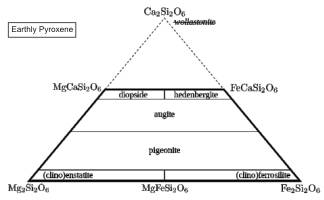The riddle of High-Calcium
Pyroxenes in S-asteroids, the earth's moon and meteorites
Norbert Brügge, Germany
Dipl.-Geol.
Something to think about:
HCP are not present in igneous rocks on
Earth. Accordingly, there is a gap at the top in the pyroxene-diagram.
The mineral wollastonite is wrongly placed here, Wollastonite
is not a pyroxene (A.
Strekeisen). It have a different type of infinite-chain structure
and is said to be secondary formed by the melting of limestone after its
subduction on Earth.
In contrast, HCPs are found
widespread in S-asteroids, the Earth's moon and also in meteorites. This
would now also apply to the suspected HCP in ultramafic rocks on Mars
(Jezero
crater). It
is likely that the evidence of wollastonite in meteorites is confused
with terrestrial wollastonite and that they are in truth the mysterious
HCPs. |
|

|
Sunshine et al. (2004)
suggest that the detected HCPs in S-asteroids were created by imaginary
melting processes in the rock. However, such a scenario is very hypothetical.
What is the real origin of the high calcium content and why is there a
lack of such evidence of HCP in igneous rocks on earth.
HCP has also been found widespread in igneous rocks
on the Earth's moon (Ogawa et al. (2011).
The detection of significant proportions of the
HCP in two examined achondritic meteorites is particularly interesting
because they could be examined directly (Takeda et al. (2005):
"High-Ca pyroxenes have been a minor component in chondrites
and HED achodrites. We report two new achondrites (NWA-2235 and 2236)
which contain more high-Ca pyroxenes than previously described. We propose
that the high-Ca pyroxenes are important component in partial melts of
(chondritic source ?) materials. Sunshine et al. performed analyses of
reflectance spectra of several S-type asteroids (Thetis and the Merxia
and Agnia family members) and found that ratios of high-Ca pyroxene to
total pyroxene are clearly inconsistent with any known chondritic material." |
Sources
Sunshine et al. (2004) -- High-Calcium
Pyroxene as an indicator of igneous differentiation in asteroids and meteorites.
Meteoritics & Planetary Science 39, Nr 8, 1343-1357
Takeda et al. (2005) -- New achondrites
wuth High-Calcium Pyroxene and its implication for igneous differentiation
of asteroids.
Lunar and Planetary Science XXXVI (2005), 1298.pdf
Ogawa et al. (2011) -- The widespread
occurrence of High-Calcium Pyroxene in bright-ray craters on the Moon and
implications for lunar-crust composition.
Geophysical research Letters, vol. 38, L17202
|